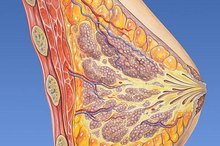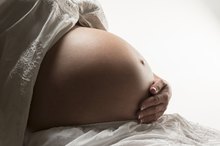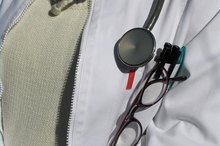Menopause and Nipple Soreness
When a woman is going through peri-menopause and entering into menopause, her breasts and nipples might become so sore that she can’t bear to lie on her stomach. This is caused by fluctuating hormones. When only the nipples get sore, it can indicate that a fungal or bacterial infection might be present or it could be caused by inadequate secretion from the sebaceous glands of the areola. These secretions normally keep the nipples supple.
Why It Occurs
According to Menopausallifestyle.com, the main reasons that nipples and breasts get sore is due to the actions of estrogen, a hormone that peaks before ovulation, and progesterone, another hormone that surfaces at ovulation. Estrogen can actually cause breast tissue to increase, which causes pain. Progesterone causes water retention, which can also make your breasts and nipples sore. When water is stored in the breast tissue, the breast stretches.
- According to Menopausallifestyle.com, the main reasons that nipples and breasts get sore is due to the actions of estrogen, a hormone that peaks before ovulation, and progesterone, another hormone that surfaces at ovulation.
- Progesterone causes water retention, which can also make your breasts and nipples sore.
Characteristics
Do Breasts Get Sore When Ovulating?
Learn More
Nipple symptoms that a menopausal woman might experience include tenderness, cracking of the surface of the nipple, redness and discharge, according to Menopausal-solutions.com 1. This can be the result of hormones in flux or it can indicate something else.
Warning
Women always need to be cognizant of their breasts, how they feel, what they look like and if there are obvious changes because breast cancer is too prevalent to ignore. If your nipple tenderness is severe, this needs to be discussed with your doctor. If the nipple discharge is clear and sticky, dark, bloody, or occurs even though the nipple hasn’t been squeezed, this can indicate the presence of breast cancer. If your nipples start drawing inward or point in a new direction or invert, these, too, can be signs of breast cancer.
- Women always need to be cognizant of their breasts, how they feel, what they look like and if there are obvious changes because breast cancer is too prevalent to ignore.
- If your nipples start drawing inward or point in a new direction or invert, these, too, can be signs of breast cancer.
What to Look For
The Effects of Progesterone on the Breasts
Learn More
If you noticed scaliness or redness on your nipple, or either of those conditions on the skin of your breast, this is not a good sign. If you discover a knot or lump anywhere in your breast or armpit, see a doctor immediately. If a lump or any thickening of the breast or nipple doesn’t resolve after a menstrual period, which peri-menopausal women still have, this needs to be addressed as well. Breast puckering, dimpling or the appearance of indentations is an indicator of breast cancer.
- If you noticed scaliness or redness on your nipple, or either of those conditions on the skin of your breast, this is not a good sign.
Climacteric Syndrome
Sore nipples and breasts are often the outcome of what is called climacteric syndrome, which entails headaches, irregular menstruation, mood changes, hot flashes, weight gain and bloating and sleeplessness. This syndrome is the result of fluctuating hormones and ovaries that are no longer functioning regularly. However, if you have concerns about your nipples and your breasts, do no hesitate to make an appointment with your physician.
- Sore nipples and breasts are often the outcome of what is called climacteric syndrome, which entails headaches, irregular menstruation, mood changes, hot flashes, weight gain and bloating and sleeplessness.
- This syndrome is the result of fluctuating hormones and ovaries that are no longer functioning regularly.
Related Articles
References
- Healthy-menopause-solutions.com
- McKay M, Coad R. A brother and sister with breast cancer, BRCA2 mutations and bilateral supernumerary nipples. Annals of Translational Medicine. 2017. 5(5):106. doi:10.21037/atm.2017.03.02
- Kliegman R, Stanton B, St. Geme J, and Schor N. Nelson Textbook of Pediatrics. 20th ed. Philadelphia, PA: Elsevier; 2016.
- McKay M, Coad R. A brother and sister with breast cancer, BRCA2 mutations and bilateral supernumerary nipples. Annals of Translational Medicine. 2017. 5(5):106. doi:10.21037/atm.2017.03.02
- National Institutes of Health. Supernumerary Nipple.
Writer Bio
Cindi Pearce is a graduate of Ohio University, where she received her bachelor’s degree in journalism. She completed both the undergraduate and graduate courses offered by the Institute of Children’s Literature. Pearce has been writing professionally for over 30 years.








